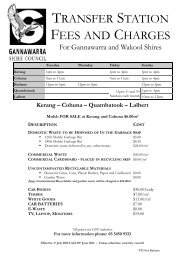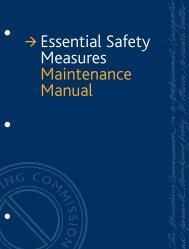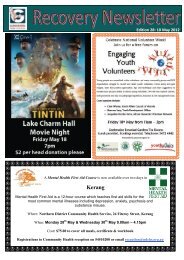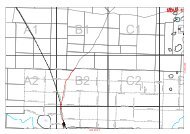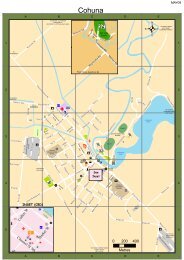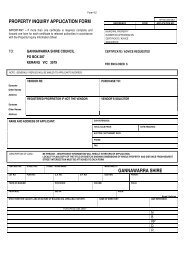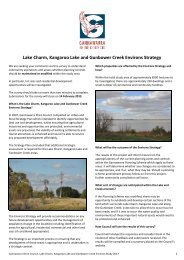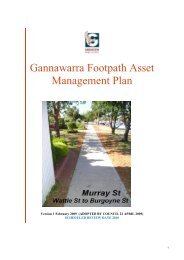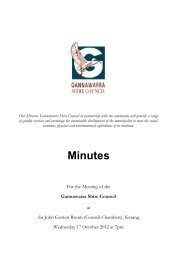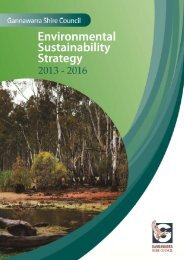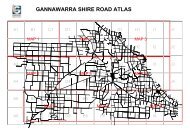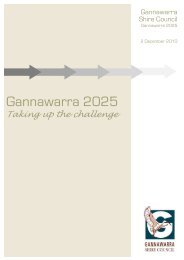Southern Loddon Mallee Regional Strategic Plan 1 - Macedon ...
Southern Loddon Mallee Regional Strategic Plan 1 - Macedon ...
Southern Loddon Mallee Regional Strategic Plan 1 - Macedon ...
Create successful ePaper yourself
Turn your PDF publications into a flip-book with our unique Google optimized e-Paper software.
Basis for action:<br />
The projected growth of Melbourne to five million people before<br />
2030 is likely to intensify population growth within our region,<br />
particularly in Greater Bendigo, the <strong>Macedon</strong> Ranges and Mount<br />
Alexander. Current trends show lesser growth in Central Goldfields<br />
and <strong>Loddon</strong> Shires. Our region has strong settlement patterns<br />
with towns nestled in the surrounding forests and agricultural<br />
landscapes. These non-urban breaks must be protected. Detailed<br />
capacity analysis and growth area planning for settlements is<br />
required to protect the lifestyle that attracts so many new residents<br />
to our region.<br />
Our settlement patterns<br />
Our region’s settlement patterns and character are heavily<br />
influenced by the gold rush era. Most of our main towns, including<br />
Bendigo, Castlemaine, Kyneton, Gisborne, Maryborough and<br />
Wedderburn, were either important gold production areas or<br />
key staging posts for those travelling between the goldfields<br />
and Melbourne. The strong character of the settlements is<br />
defined by the surrounding bush or rural landscapes which<br />
significantly enhances their amenity. Rural residential land uses are<br />
concentrated in and near major towns primarily on the outskirts of<br />
Bendigo and towns along the Calder Corridor.<br />
Existing settlement patterns are concentrated around established<br />
towns, the metropolitan Melbourne interface, and major road<br />
and rail transport links to Melbourne, Bendigo and Ballarat. Towns<br />
across the region form a network connected by transport routes<br />
and accommodate the majority of our residential, employment<br />
and industrial land uses.<br />
Significant areas of public land are retained for nature<br />
conservation, forestry and other uses. Our region includes<br />
important conservation reserves, including the Castlemaine<br />
Diggings National Heritage Park and the Terrick Terrick and<br />
Greater Bendigo National Parks.<br />
These attributes contribute to a strong settlement character<br />
with a diversity of distinct and defined townships separated<br />
by either the surrounding bush or rural landscapes.<br />
Population growth<br />
In 2006 our region’s population was 175,220, representing a<br />
growth of approximately 5,000 people since 2001. The Victorian<br />
Government projects that our region will grow to over 233,000<br />
people by 2026. The projected annual rate of growth (1.7%) is<br />
almost 50% greater than the average for regional Victoria overall.<br />
Most of the projected growth is expected to be concentrated in<br />
Greater Bendigo, <strong>Macedon</strong> Ranges and Mount Alexander with<br />
lower growth in Central Goldfields and a population decrease in<br />
<strong>Loddon</strong>. The region has become a popular lifestyle alternative<br />
to metropolitan Melbourne due to its proximity, accessibility,<br />
and attractiveness. The improvements to the rail and road<br />
infrastructure of the Calder Transport Corridor have also influenced<br />
growth in the region.<br />
Continuing to plan for future population growth and associated<br />
urban growth is essential to retaining our region’s liveability, natural<br />
assets and heritage character. The growth pressures in Melbourne’s<br />
hinterland are significant. The distinct rural and bush buffers<br />
between our settlements shall be protected and retained, and<br />
urban sprawl prevented. Detailed settlement planning will identify<br />
the capacity of towns for growth incorporating environmental,<br />
physical and services opportunities and constraints. The amount<br />
and location of urban growth must be carefully managed to avoid<br />
the challenges that uneven distribution of population growth<br />
would present.<br />
The majority of anticipated growth will be accommodated in<br />
Bendigo, the provincial centre, where there are nominated growth<br />
areas located within an urban growth boundary. Currently all<br />
other settlements within the region are towns and small towns<br />
with populations of less than 10,000 people. Depending on where<br />
growth is directed, the role and function of some of the larger<br />
settlements may change to become district centres. Further<br />
settlement planning will determine the preferred future role<br />
and function of these towns and include strategies to direct and<br />
manage growth within the region.<br />
Capacity for growth<br />
The capacity for expansion of many of our settlements is limited by<br />
surrounding forest. Proximity to bushland also means that these<br />
settlements are exposed to risk from fire. Urban expansion needs<br />
to be carefully considered, particularly in the light of findings from<br />
the 2009 Bushfires Royal Commission.<br />
<strong>Macedon</strong>, Woodend and Gisborne are significant lifestyle<br />
towns with more than 40% of their populations commuting to<br />
Melbourne. With the recent rapid growth in population predicted<br />
to continue, <strong>Macedon</strong> Ranges Shire are currently undertaking<br />
detailed settlement planning to determine where to direct<br />
population growth and the future role and function of these<br />
settlements.<br />
The towns of Castlemaine, Chewton, Campbells Creek, Maldon<br />
and Newstead will be capable of meeting projected population<br />
growth. In Harcourt, a major upgrade of the wastewater transfer<br />
main will be required in order to cope with the projected<br />
population growth. For the currently unsewered towns of<br />
Elphinstone, Taradale and Guildford an innovative wastewater<br />
management system will be necessary to accommodate the<br />
projected growth, as the cost to connect the towns to sewer is<br />
likely to be very high.<br />
Maryborough has significant infrastructure and is capable of<br />
accommodating population growth. Whilst current projections<br />
are modest, there are strategies in place to attract residents and<br />
promote growth of the town. Smaller towns such as Clunes<br />
and Talbot have capacity for growth if the appropriate sewer<br />
infrastructure is provided.<br />
Towns in the <strong>Loddon</strong> Shire are located in Bendigo’s hinterland<br />
and could provide alternative lifestyle opportunities to living<br />
in the provincial centre. To facilitate such growth secure water<br />
supplies need to be implemented in towns such as Bridgewater,<br />
Newbridge, Inglewood and Laanecoorie.<br />
Bendigo<br />
Bendigo is the provincial centre servicing the broader region and<br />
is projected to experience the highest levels of growth. As one of<br />
Victoria’s regional cities, Bendigo is a service and employment hub<br />
with a diversity and depth of cultural, tourism and entertainment<br />
facilities. As the population of Greater Bendigo and our region<br />
grows, the city must adapt to provide the necessary health,<br />
education and employment services and infrastructure for a larger<br />
population.<br />
Settlement planning has been undertaken for Greater Bendigo to<br />
identify growth areas for new housing and industrial development.<br />
However, outward growth of the city is constrained by the<br />
surrounding forest. The development of infill sites, higher density<br />
housing and other urban consolidation initiatives will assist in<br />
providing appropriate accommodation choices.<br />
<strong>Southern</strong> <strong>Loddon</strong> <strong>Mallee</strong> <strong>Regional</strong> <strong>Strategic</strong> <strong>Plan</strong> 13




